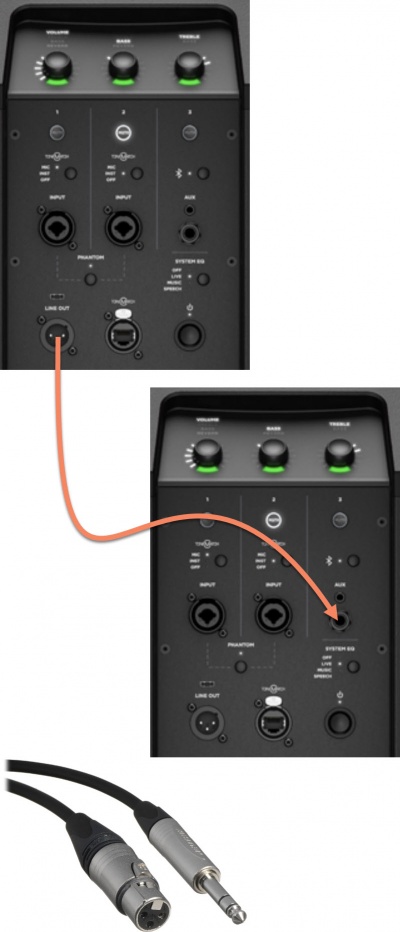Difference between revisions of "L1 Pro Daisy Chain"
m |
m |
||
| (8 intermediate revisions by the same user not shown) | |||
| Line 1: | Line 1: | ||
| − | + | {{L1 Pro icon}} | |
| − | To connect | + | To connect two L1 Pro systems (daisy chain) to use the second system as an extension of the first |
#Use an XLR female to 1/4 inch (6.3 mm) Tip-Ring-Sleeve to connect the L1 Pro Line Out to a second L1 Pro (any model) input three | #Use an XLR female to 1/4 inch (6.3 mm) Tip-Ring-Sleeve to connect the L1 Pro Line Out to a second L1 Pro (any model) input three | ||
| − | #Set the volume on the second L1 Pro to suit the application. | + | |
| + | # Turn down the volume on the second L1 Pro | ||
| + | # Set the level you want on the first L1 Pro | ||
| + | # Set the volume on the second L1 Pro to suit the application | ||
| + | # Note: Running two L1 Pros daisy chained in close proximity offer little tangible benefit and can cause issues with multiple source interference. See [[Dual Mono]] for details. | ||
| + | |||
| + | |||
| + | |||
| + | ;Note: | ||
| + | The Line Out is post-fader. That is, it is the combined signal of all inputs and ToneMatch processing, EQ and Reverb. That includes inputs, 1, 2, 3, Bluetooth, and ToneMatch Port (used for {{ToneMatch Mixers}}). | ||
| + | |||
| + | The Line Out is pre-System EQ. That is, the signal at the Line Out is flat. It is not affected by the setting of the System EQ switch. <ref>[https://www.facebook.com/groups/BoseL1/permalink/10159715041622446/?comment_id=10159715092547446 Craig Small - Bose]</ref> | ||
This applies to any two L1 Pro systems (L1 Pro8, L1 Pro16, L1 Pro32). | This applies to any two L1 Pro systems (L1 Pro8, L1 Pro16, L1 Pro32). | ||
| + | |||
| + | [[File:L1 Pro Daisy Chain.jpg|400px|L1 Pro Daisy Chain]] | ||
| + | |||
| + | ; Second L1 Pro Louder than the First | ||
| + | Because the output level of the first L1 Pro Line Out is post-fader (see above) is higher than the original source. If you set the volume controls on the second L1 Pro to the same settings as the first L1 Pro, the second one will be louder. To get the levels the same, | ||
| + | # Turn down the volume on the second L1 Pro | ||
| + | # Set the level you want on the first L1 Pro | ||
| + | # Set the volume on the second L1 Pro to suit the application. Do that by ear. | ||
| + | |||
| + | ; Dual Mono | ||
| + | When you run the same sound through two L1 systems, you should consider the consequences, both good and bad. See [[Dual Mono]] for details. | ||
Latest revision as of 22:06, 12 April 2023
To connect two L1 Pro systems (daisy chain) to use the second system as an extension of the first
- Use an XLR female to 1/4 inch (6.3 mm) Tip-Ring-Sleeve to connect the L1 Pro Line Out to a second L1 Pro (any model) input three
- Turn down the volume on the second L1 Pro
- Set the level you want on the first L1 Pro
- Set the volume on the second L1 Pro to suit the application
- Note: Running two L1 Pros daisy chained in close proximity offer little tangible benefit and can cause issues with multiple source interference. See Dual Mono for details.
- Note
The Line Out is post-fader. That is, it is the combined signal of all inputs and ToneMatch processing, EQ and Reverb. That includes inputs, 1, 2, 3, Bluetooth, and ToneMatch Port (used for T4S/T8S ToneMatch® Mixers).
The Line Out is pre-System EQ. That is, the signal at the Line Out is flat. It is not affected by the setting of the System EQ switch. [1]
This applies to any two L1 Pro systems (L1 Pro8, L1 Pro16, L1 Pro32).
- Second L1 Pro Louder than the First
Because the output level of the first L1 Pro Line Out is post-fader (see above) is higher than the original source. If you set the volume controls on the second L1 Pro to the same settings as the first L1 Pro, the second one will be louder. To get the levels the same,
- Turn down the volume on the second L1 Pro
- Set the level you want on the first L1 Pro
- Set the volume on the second L1 Pro to suit the application. Do that by ear.
- Dual Mono
When you run the same sound through two L1 systems, you should consider the consequences, both good and bad. See Dual Mono for details.
